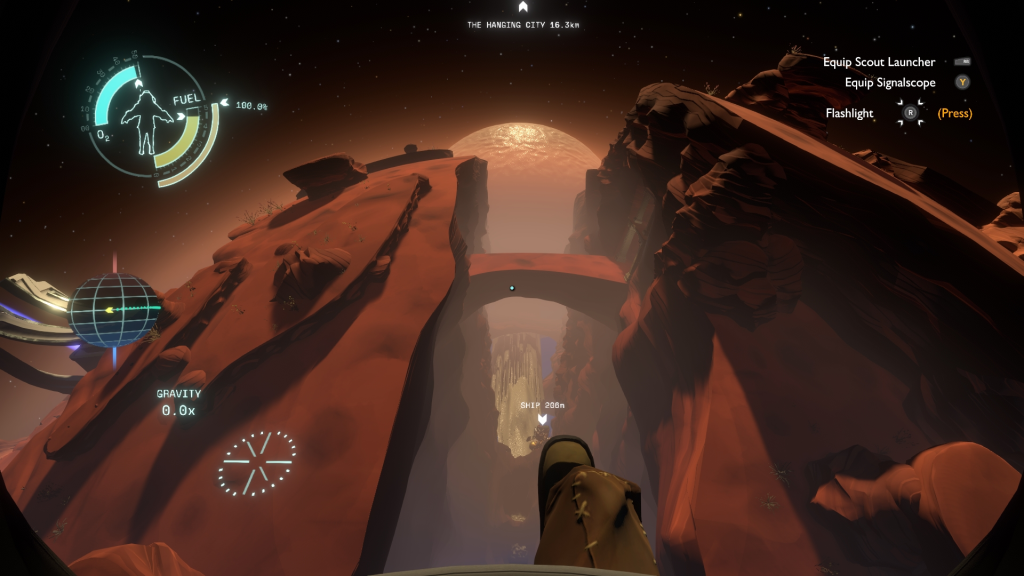OUTER WILDS
Mobius Digital
2019
Xbox, Playstation, PC, Switch
Time loop games tend to operate in one of two models. There’s the time loop that serves as a justification for clockwork gameplay mechanisms, encouraging the player to master the sequence events and execute on the “perfect run.” In some cases, this functions about the same as a quick retry button, but the narrative justification allows for a little more exploration of alternate consequences. There’s also time loops that serve as branching path narratives – if you create one chance meeting on day one and pursue that story, what’s the butterfly effect to day three when everyone else is still on script?
Outer Wilds is not quite either, though there are certainly consequential events and precise timings rewarding attention to detail. You play as a space explorer who, on the day they’re to take their little ship into the solar system, gets locked into a time loop which ends each day with supernova and armageddon. You have 22 minutes to advance from your home of Timber Hearth into the alien landscapes and prehistoric ruins of planets settled by the ancient (?) Nomai civilization. Your primary goal is to investigate the mysteries of the supernova, the Nomai’s demise, and the current status of the other Hearthian explorers. The game tracks this in a convenient journal on your ship and pins questions to your idea map, but it never offers obvious waypoints or quest markers.
The time loop primarily controls the solar system’s simulation. Weather on the oceanic planet Giant’s Deep operates on a storm cycle you can learn and, eventually, use to explore the planet’s truth. A portion of the planet Brittle Hollow breaks off at the same time each cycle and falls into a black hole that has opened at its core – to see that part of the planet, you’ll either need to arrive quickly or figure out how to navigate to it within the black hole itself. The Interloper is an icy comet that travels on the same portion of its orbit with each time cycle – that orbit affects the temperature on the comet’s surface, altering the ice pattern and your ability to navigate the surface.

You, too, exist as a part of this physics simulation. Gravity varies wildly based on your location, and your fragile little body is easy to send into the abyss and back through the loop if you’re not careful. The spaceship controls a little like the classic arcade game Lunar Lander – your body inverts the standard video game jump so that hitting the button bends your knees and releasing causes you to jump however high your body goes based on the gravitational forces near you. Learning this mobility is, for a lot of players, the brick wall that prevents interest in seeing this mystery through to its conclusion. For me, it took some practice but in the end felt natural – I was able to pick up these controls again quickly upon playing the DLC expansion Echoes of the Eye, a new mystery that builds nicely into the game’s story.
And it is that story which I think makes the game so special. The time loop, physics simulation of the game is delightful, but it is the natural science and archaeology that are so rewarding. Ultimately, Outer Wilds is a story about the end of the world – some Nomai predicted an eventual demise, others built into eternal denial. The eventual answers to the mysteries of the Outer Wilds both confront the player with futility and peace. The game’s true ending, without delving into spoilers, is a celebration of life and its ending. It’s a moving, emotional sequence that both offers outrageous spectacle and aesthetic quiet.
Special notice must be given to the game’s fantastic soundtrack. Composed by Andrew Prahlow, the score is a combination of campfire acoustica and synth majesty. It combines the Hearthian’s forest fire architecture with the unknowable mystery out in the stars. The “Main Title” and “Travelers” are songs I listen to frequently. The synth line that begins to play near the end of a loop is catchy and unmistakable without being trite or dreadful. I hope to hear more scores from him someday soon.